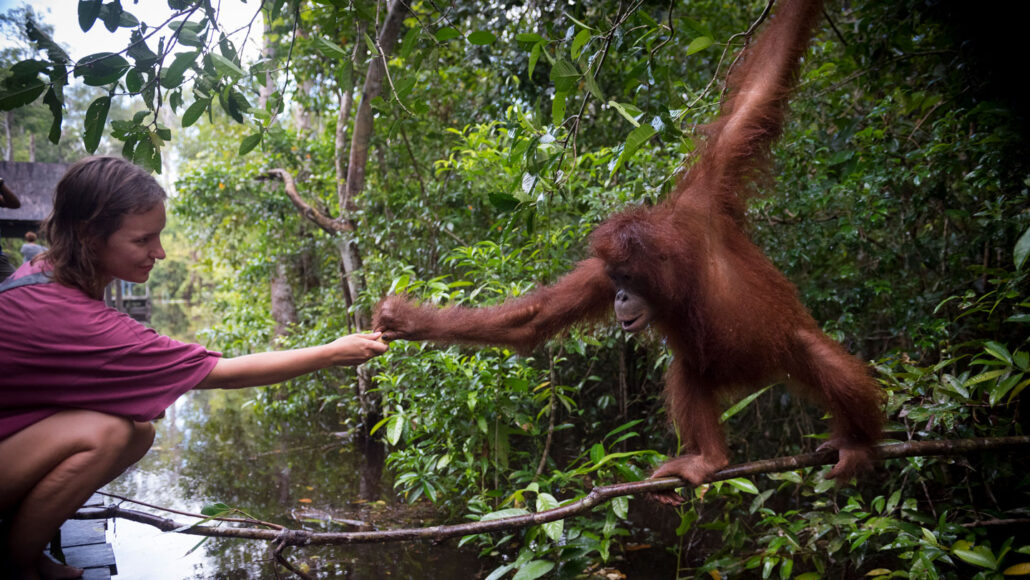baboon: A large ground-dwelling African monkey with a long, doglike snout and large teeth. Baboons are social animals and live in troops.
bushbabies: Also known as galagos, these are small, large-eyed, nocturnal, tree-dwelling African primates. They get their name for their baby-like cries. Known as vertical clingers and leapers, they can spring off the trunk of one tree and turn around in mid-air to face the next tree it will latch onto.
digit: A structure, like a finger or toe, at the end of the limbs of many vertebrates.
DNA: (short for deoxyribonucleic acid) A long, double-stranded and spiral-shaped molecule inside most living cells that carries genetic instructions. It is built on a backbone of phosphorus, oxygen, and carbon atoms. In all living things, from plants and animals to microbes, these instructions tell cells which molecules to make.
family: A taxonomic group consisting of at least one genus of organisms.
forest: An area of land covered mostly with trees and other woody plants.
gibbon: A small, slender ape with long arms.
great ape: A term for most apes (large primates that lack a tail). These include gorillas, chimpanzees, bonobos, orangutans and humans. Most scientists tend to group humans into their own separate subcategory owing to a number of special traits. These include a larger brain, greater mental abilities (including being able to talk) and their ability to walk on two legs. The only “lesser” ape is the gibbon.
howler monkeys: Monkey species found in Central and South America, including the Amazon. They are well-known for their loud howling, which can sometimes be heard several kilometers (miles) away .
lemur: Any of many primate species that tends to have a cat-shaped body and usually a long tail. They evolved in Africa long ago, then migrated to what is now Madagascar, before this island became separated from the east coast of Africa. Today, all wild lemurs (some 33 species of them) live only on the island of Madagascar.
literally: A term that the phrase that it modifies is precisely true. For instance, to say: "It's so cold that I'm literally dying," means that this person actually expects to soon be dead, the result of getting too cold.
loris: Primates that belong to a group known as the Lorisiformes . These include Asian lorises and their close African relatives, the pottos and angwantibos. The cat-sized animals tend to move slowly. They hide out on the upper branches and vines in forests. Another member of this group, the far tinier galagos, live in Africa. These primates are known for their ability to leap quickly from one tree trunk to another by pushing off backwards into the air, then turning around mid-air to grasp onto the new trunk. Nocturnal animals, they have relatively big eyes. Owing to the unusual mode of travel by galagos (or bush babies), scientists often refer to these animals as “vertical clingers and leapers.”
macaque: A monkey with cheek pouches and a short tail that lives mainly in the forest.
mammal: A warm-blooded animal distinguished by the possession of hair or fur, the secretion of milk by females for feeding their young, and (typically) the bearing of live young.
orangutan: One of the great apes (which also include humans, gorillas, chimpanzees and bonobos), this red-haired tree dweller shares 97 percent of its genes in common with humans. They can live for 60 years, with adults weighing 48 to 130 kilograms (105 to 286 pounds) depending on gender, age and health, with males being bigger. They have opposable thumbs (as humans do) and also opposable big toes, which aids in their gripping.
primate: The order of mammals that includes humans, apes, monkeys and related animals (such as tarsiers, the Daubentonia and other lemurs).
range: The full extent or distribution of something. For instance, a plant or animal’s range is the area over which it naturally exists. (in math or for measurements) The extent to which values can vary (such as the highest to lowest temperatures). Also, the distance within which something can be reached or perceived.
social: (adj.) Relating to gatherings of people; a term for animals (or people) that prefer to exist in groups. (noun) A gathering of people, for instance those who belong to a club or other organization, for the purpose of enjoying each other’s company.
species: A group of similar organisms capable of producing offspring that can survive and reproduce.
trait: A characteristic feature of something. (in genetics) A quality or characteristic that can be inherited.

